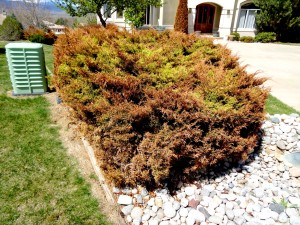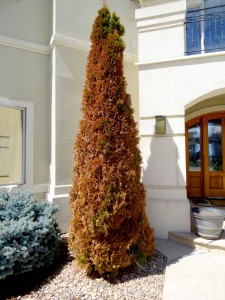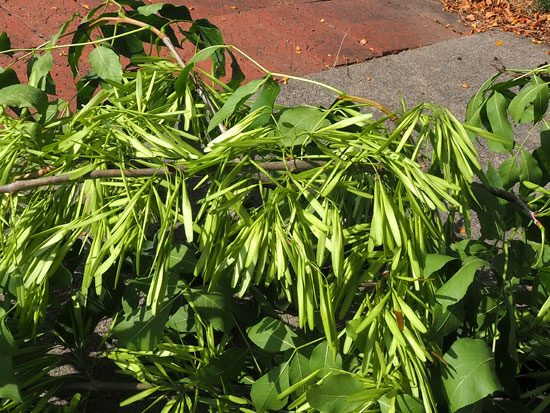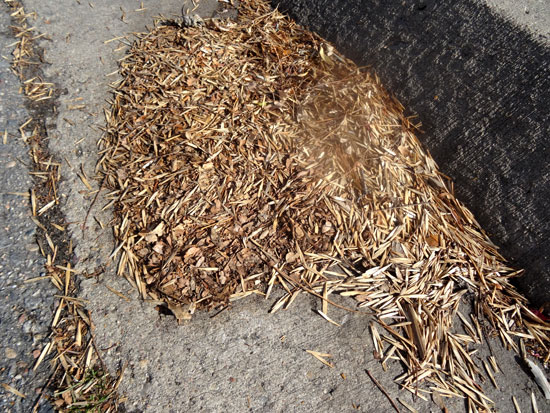Author Archives: Stef
Our Worst Weed Problem
Everybody’s concerned about the Emerald Ash Borer killing ash trees and with good reason. If you have a specimen ash tree in your yard and it dies, it’s a big loss. Those valuable trees should be treated right away.
However, female ash trees put out thousands of seeds each year. Those seeds become weeds. They’re weeds in your lawn. They’re weeds in your gardens. Above all they’re weeds crowding out native plants in open space and particularly in riparian areas.
Hundreds of ash seeds on just one limb
Ecologists are worried about other invasive plants in the riparian areas, but nobody talks about the invasive ash trees. Yes, Russian Olive trees can be a huge problem, but in my opinion the green ash invasion will be worse. Some believe that crack willows are a problem, but I think that problem is overstated. (I’m biased. I like willows – check out my page “The Willows of Colorado”). The massive distribution of green ash seeds will lead to problems worse than either olives or willows.
Hundreds of ash seeds on the ground
One year I did a (very) informal survey and estimated that there were, on average, a hundred ash seeds per square meter in the entire City of Boulder. Wow! That’s a lot of weed trees. Yes, when they mature, the Emerald Ash Borer will kill some of them, but not until they become large trees. They’ll still be a huge problem in your yard and in the open space areas.
I believe that the number one concern of people removing invasive trees should be female green ash trees. Forget about Russian Olive and Crack Willow for a little while. Don’t worry about the male ash trees – they don’t have seeds. In the mountain parks, along the creeks, in Sawhill and Walden Ponds, and in the open space areas, get rid of the female ash trees now before they can spread thousands of more seeds and crowd out thousands more native plants.
If you have a female green ash in your yard, one that has seeds, and you don’t really love it – consider removing it. You’d be doing all your neighbors a big favor. People are spending their weekends on their hands and knees pulling baby ash trees out of their lawns and gardens.
Stef Ringgenberg
Treat For Emerald Ash Borer Now!
I had my “Oh no, this is getting serious!” moment about Emerald Ash Borer last weekend.
I went to give a homeowner an estimate for preventive control and discovered the tree was already beyond saving. The tree was in Table Mesa area of southwest Boulder. There were adult beetles on the tree which led me to find multiple exit holes on the trunk, but I knew as soon as I walked into the yard that there was a problem. There were still had leaves over the entire tree but the leaves were about a quarter of the size they should be. The leaflets were no more than an inch long. Clearly the tree was dying.
So, one possible symptom to detect an infestation of the Emerald Ash Borer on a particular limb or on the whole tree is dramatically smaller leaves. I’ve seen trees where only one small limb has that symptom – an early indicator.
The ash population in Boulder is in trouble this year even without the Emerald Ash Borer. Many trees are half dead with some leads completely dead and others still kicking. I’ve stripped bark and there are no borers involved. Three years of early season freeze injury and the November freeze drying have taken their toll. When I stripped bark, however, I did find canker fungi which I have not identified, but there were definite fruiting bodies. I don’t know if the fungi are secondary to the weather of if the fungi are the primary killers. It’s interesting that some trees are half dead and other ashes, with all the rain, are just robustly healthy.
Anyway, the EAB problem in Boulder is at the critical stage. There’s no more waiting. It’s time to either treat the trees or lose them. I think an important role for the arborist community at this stage is to help owners decide whether the trees should be saved. Clearly only healthy specimen trees with good structure are worth the expense of the costly treatments and the tradeoff of possible environmental side effects.
Stef Ringgenberg
Boulder Tree & Landscape Consulting
Winter Freeze Injury to Plants
Sudden Freeze Injury to Plants
Many evergreen shrubs and trees are showing injury from the nasty drop in temperature we had in November of 2014. The temperature on November 10th was in the 60s. On November 12th the temperature dropped to the lowest temperature for that date in history – one degree below zero. That’s a swing of over 60 degrees, one of the largest temperature drops in history. It’s not the low temperature but the sudden change of temperature that does the damage. We expect widespread plant injury to rear its ugly head this spring.
Junipers are one plant genera that were hit hard. Many junipers have significant browning and foliar death. That includes both shrubs and tree types of junipers. Other plants that are showing injury are Scotch and ponderosa pines, and arborvitae. Many broadleaf evergreens such as euonymus, pyracantha, and daphne have dead leaves. Many deciduous trees and shrubs never completed their fall leaf drop and the leaves persist on the trees. I’ve heard reports of dead burning bushes and roses.
I’ve heard reports of dead burning bushes and roses.
Plants must protect themselves against freezing. Even plants that are hardy for this climate zone must harden for the winter or they die. If water freezes inside a cell, the ice crystals puncture the cell membranes and the cell dies. Plants either create anti-freeze in the cell, or transfer water out of their cells to protect them from freezing. However, the process takes time. As the temperature drops in the fall, the cells gradually harden themselves against freeze. If the daytime temperature is high, the hardening process may be delayed. In November 2014, the trees and shrubs didn’t have the time to harden adequately and we’re seeing the unfortunate result.
 One common misconception is that too much water or fertilizer in the late summer can cause succulent growth that won’t harden properly in the fall. In truth, winter hardening is a metabolic process that requires energy, and depriving the plant of water or adequate fertilizer will slow down the trees metabolism and hinder the winter hardening process. Healthy vigorous plants can tolerate stress much better than weaker plants.
One common misconception is that too much water or fertilizer in the late summer can cause succulent growth that won’t harden properly in the fall. In truth, winter hardening is a metabolic process that requires energy, and depriving the plant of water or adequate fertilizer will slow down the trees metabolism and hinder the winter hardening process. Healthy vigorous plants can tolerate stress much better than weaker plants.
The question is what can we do to help the plants now? I think the best answer is to be patient. Wait and see how the plants recover. Often the freeze kills existing foliage but leaves the buds alive to put on new foliage in the spring. The plants may recover. Don’t try to prune the dead out now. I’ve already seen plants ruined from people trying to prune out the freeze injury. Don’t fertilize now. Fertilizer is not plant food, it provides no energy, only essential elements. In fact fertilizer is a short term energy drain on the plants because energy is required for plants to take up the fertilizer. The plants can’t spare that energy now. It will take all their stored reserves to replace lost tissues.
Many plants did no complete their fall leaf drop, a process called abscission. One job of the abscission process is to block the vascular system to prevent water loss from the plant. The winter freeze may have left the vascular system open to water loss in many plants. Therefore, winter watering may be more important than normal. Fortunately, this winter has been fairly moist in Boulder and winter watering, for the most part, hasn’t been needed.
If you have questions about your plants or need recommendations on their care, give us a call to set up a consultation. 303-530-0640.
3 Bears in a Spruce Tree
A mother bear and her two cubs spent the day sleeping in a spruce tree near
the Chautauqua auditorium in Boulder, Colorado. If Bears are trapped in town,
they are tagged and relocated. If they are caught a second time they, unfortunately, must be destroyed. To our great relief, we were able to chase these bears back to the wild area so their lives wouldn’t be at risk.



